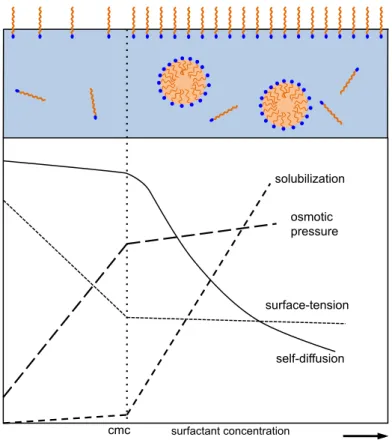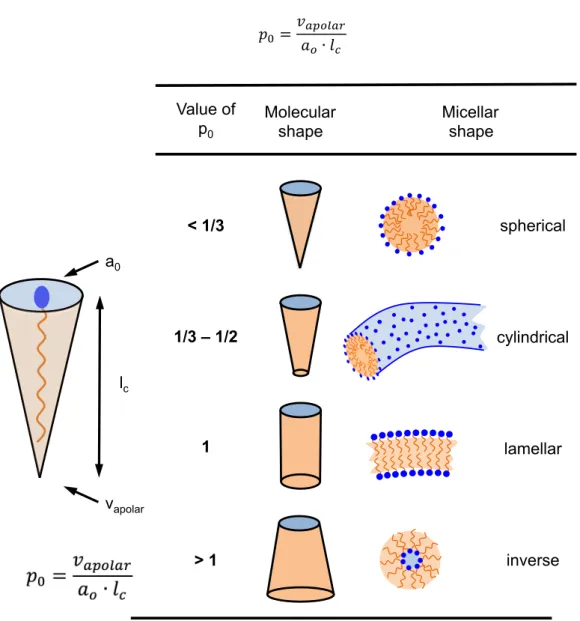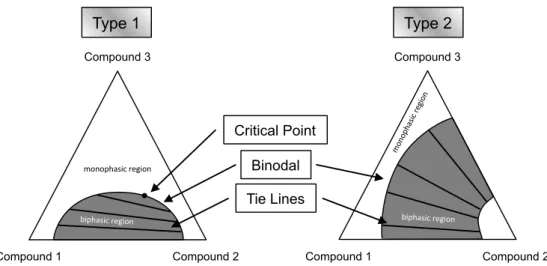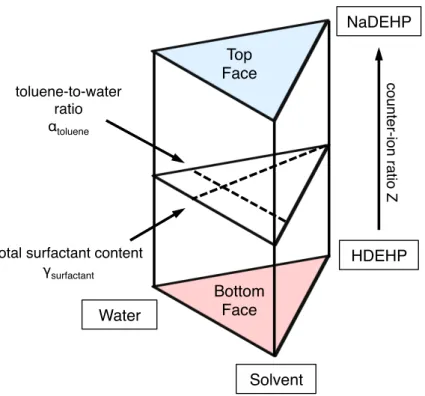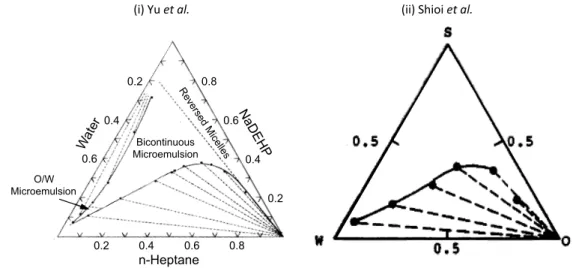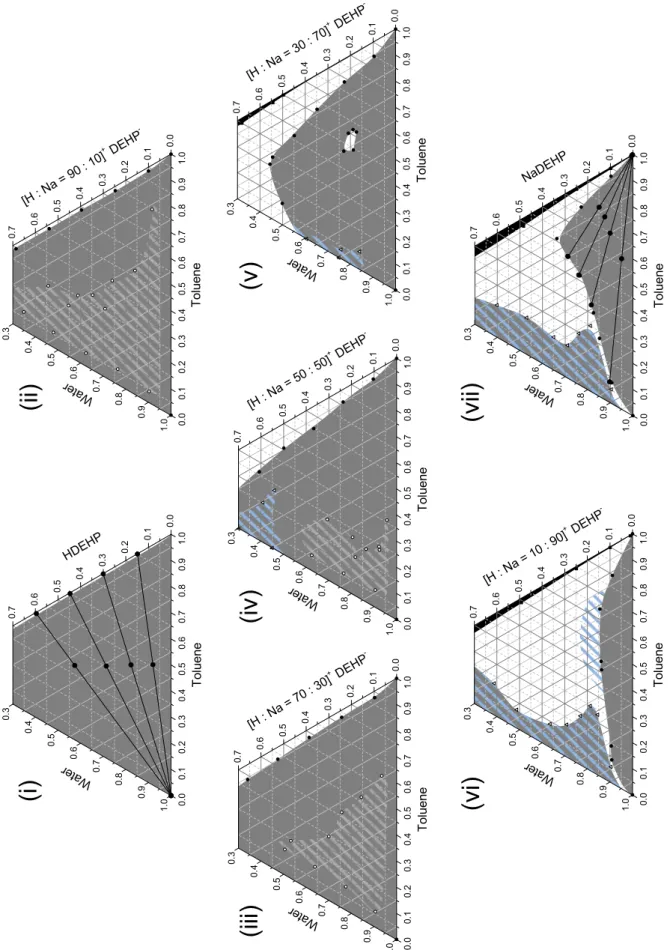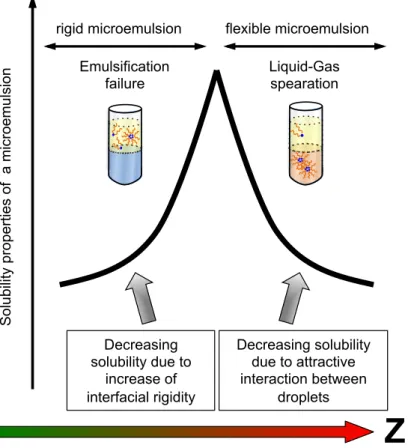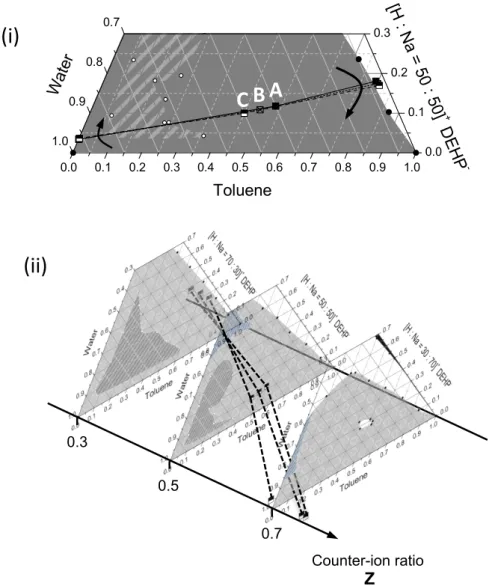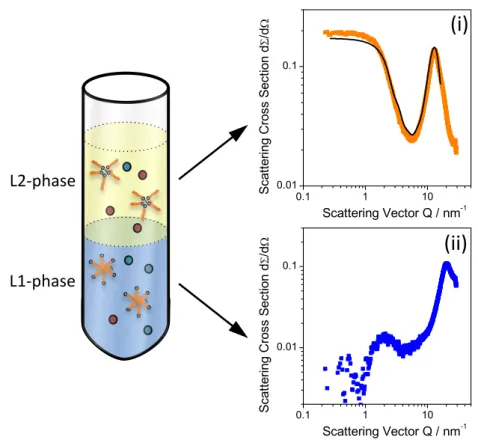I
RAPPORT DE GESTION 2015
DISSERTATION PRESENTED FOR THE DEGREE OF DOCTOR OF NATURAL SCIENCE (DR. RER. NAT.) A CO-TUTELLE OF THE UNIVERSITY OF MONTPELLIER
AND THE UNIVERSITY OF REGENSBURG
Presented by Tobias LOPIAN 29/09/2017
Under the supervision of Prof. Thomas Zemb An Prof. Werner KUNZ
Composition of the jury
Werner KUNZ, Prof., Universität Regensburg
Michael GRADZIELSKI, Prof., Technische Universität Berlin Yves CHEVALIER, Directeur de Recherche, Université Lyon 1 Julian OBERDISSE, Directeur de Recherhe, Université Montpellier Richard BUCHNER, Prof., Universität Regensburg
Thomas ZEMB, Prof., Université Montpellier Sandrine DOURDAIN, Dr., CEA
Reporter / Ph. D. Director Reporter
Reporter Adjudicator Adjudicator
Adjudicator / Ph. D. Director Supervisor
Characterization of a metal-extracting water-poor
microemulsion
II
III
Preface
This PhD thesis was Co-Tutelle between the partner-universities of Montpellier, France and Regensburg, Germany, between December 2014 and November 2017. In France, this work has been carried out at the Laboratoire du Tri ionique par les Systèmes Moléculaires auto- assemblés (LTSM), which is part of the Institut de Chimie Séparative de Marcoule (ICSM) at the French commissary for atomic energy (CEA). It is implemented in the ERC-project REEcycle in the work-package IV (Exploring new formulations increasing pH window and selectivity). In Germany, this work has been carried out at the Institute of Physical and Theoretical Chemistry, Faculty of Natural Science IV, University of Regensburg. Prof. Dr.
Thomas Zemb and Prof. Dr. W. Kunz have guided this work as PhD directors and supervised by Dr. Sandrine Dourdain. This work would not have been possible without the great support from many people. Therefore, I want to express my profound gratitude to the following, who contributed to the completion of my dissertation:
First of all, I would like to express my deepest gratitude for Prof. Dr. Thomas Zemb for giving me the opportunity to participate at this ERC-project, the chance to work at the ICSM and the financial support in order to complete this thesis. I am very grateful for inspiring discussions and his fruitful lessons in physical chemistry. Without his encouragement and drive, this work would have not been possible.
I want to express my sincere gratification towards Prof. Dr. Werner Kunz and his support through this PhD. His calm and patient attitude enabled establishing the Co-Tutelle contract in an Odyssey between the two partner universities. Further, I highly appreciate the possibility to carry out a considerate part of the experiments at his institute.
In addition, I want to thank Prof. Dr. Richard Buchner for the possibility to carry out conductivity and permittivity measurements in his laboratory, as well as the productive discussions.
Sincere thankfulness is owed to Sandrine Dourdain for her professional and moral support through this work. Together, we explored novel domains and learned “petit-à-petit” how to establish a red thread through this work.
I deeply want to show my tanks to Dr. Sylvain Prévost from the ILL in Grenoble. Not only did he find much interest in the subject and helped me advance in many fruitful discussions, but he also became a dear friend.
IV
Dr. Didier Touraud is gratefully acknowledged for the great discussions about phase diagrams and helping me to find specific literature.
Thanks to Prof. Dominik Horinek and Sebastian Schöttel for the collaboration on the UFME- subject and the great publications we were able to diffuse.
I’d like to express a special thanks to Hélène Martin and Vainina Russello for their incredible effort and help in administrative tasks and paper-work.
I gratefully want to thank my team of the LTSM for the pleasant time in the laboratories, in particular our chef, Dr. Stéphane Pellet-Rostaing. Thank you Guilhem, Carlos, Arthur, Beatrice, Alex and Tamir for this great time. Additionally, I want to thank all the other colleagues at the ICSM, whom I didn’t name individually.
Further, I would like to sincerely thank all my friends of the German fraction (Michael, Maximilian, Markus, Mario and Robert) and the French fraction (Julien, Alban, Laurant, Michael, Camille, Périne, Thibault, JB and many more). You made this stay in France an exceptional life-time and experience in my life. I will always cherish
Of course to my loving parents, Fritz and Evi Lopian, and my sister Dinah, for their never- ending support throughout the last years.
Last but not least my beloved girlfriend Carolin – We endured three tough years and I am endlessly grateful for your support, love and friendship throughout this work. From the bottom of my heart, I thank you.
V
VI
VII
Contents
Introduction 1
Chapter I – Introduction in fundamental concepts 5
Chapter II – Exploring stability domains in extracting
microemulsions 43
Chapter III – Exploring the conducting properties of a metal-extracting microemulsion 101
Chapter IV – Relation of the reference model with a
solvent extraction system 137
General conclusion 155
References 159
Annex 179
VIII
1
Introduction
Rare-earth elements (REE) are a set of 17 metallic elements in the periodic table, counting all 15 lanthanides and completed by Scandium and Yttrium. They become increasingly important in the transition towards a green and sustainable economy and are the origin for the technological advances in the 21st century. These metals are essential for a wide range of modern inventions, which are indispensible for the development of efficient carbon-free and environmentally benign technologies. They are an important ingredient for modern hydride batteries, hybrid and electrical cars, smartphones, HD-displays, laser-technology, refinement of crude oil, catalysis as well as for permanent magnets used in wind turbines.1 A procedure to retrieve these elements from electronic wastes in order to close the so-called
“life-cycle” of electronic devices has not been established on an industrial scale. This is reflected by the fact that less than 1% to the world wide annual production of rare earths stems from recycling projects. A major problem is caused by the chemical and physical similarity of these elements, which poses severe problems to the task of separating these metals from each other. The separation procedure of choice is solvent extraction, also called liquid-liquid extraction. In this procedure, two non-miscible solvents (usually water and an apolar organic solvent) are contacted with each other and at proper conditions a mass transfer of a desired species from one liquid to the other can be triggered. In order to retrieve rare earths from an aqueous solution, this is done using complexing agents, also called extractants, which form a reverse aggregate in the organic phase, encapsulating an extracted metal in an apolar environment. On a laboratory scale, very efficient extractant molecules have been synthesised and promising systems have been developed. However, up to date it is not possible to formulate a continuous, adaptive and predictive solvent extraction procedure on an industrial scale. One of the main reasons is the lack of a comprehensive fundamental understanding. On a laboratory scale, extraction is done in dilute conditions of the extractant in the organic phase, where interactions between complexes can be neglected. For an efficient extraction however, high concentrations of extractants are needed, leading to non-ideal behaviour in the organic phase. The origin of these interactions between complexes is yet poorly understood.
In an attempt to challenge major questions on the extraction of rare earth elements from electronic waste, the European Research Council (ERC) has granted a funding for the project REE-Cycle.2 Using a combined empiric and theoretical approach, this project aims to
INTRODUCTION
2
formulate general laws, which will allow increasing the predictability for extraction processes.
A very successful route to describe the non-ideal behaviour is the so-called colloidal approach.3 Interpretation of metal-extractant complexes as reverse micelles enables to revert to concepts known from surfactant science. Linking thermodynamic concepts of complex formation with self-assembly allows explaining why a critical concentration of extractant is often necessary to be considered in the organic phase. Further, co-extraction of water in the micellar cores has assigned such systems the term of extracting microemulsion.
Besides fundamentally understanding the physico-chemical mechanisms of a metal- extracting microemulsion, the project REEcycle aims to explore new routes in order to enhance the efficacy of an extraction. One route is the application of an external electrical field. This requires exact knowledge on the mechanisms of charge formation in apolar environment.
Therefore, in the frame of this ERC-project and in compliance with the colloidal approach, this work addresses two fundamental questions, which have yet been poorly reviewed in solvent extraction science: the macroscopic phase behaviour and the conductivity properties.
The macroscopic phase behaviour of a solvent extraction procedure is poorly understood.
However, knowledge of the phase behaviour is indispensible for chemical engineers in order to find an “optimum formulation”, i.e. when the microemulsion selectively extracts a desired metal species and possesses appropriate mechanical properties for application in continuous procedures. Additionally, mapping of the phase behaviour in diagrams shows a chemical engineer how to avoid undesired phases (such as stable emulsions and third phase formation, also called “three-phase catastrophe”).
Phase diagrams are a powerful way to describe and visualize the phase behaviour of a multi- component system and summarize a large amount of experimental data.4 In surfactant science, phase diagrams do not only map the phase behaviour of microemulsions, but they provide a link between the macroscopic behaviour and internal interactions, e.g. evolution of phase boundaries are a direct link to the solubilization capacity on a microscopic scale.
The second aspect of this work concerns the conducting behaviour of metal-extracting microemulsions. Up to date, micelles in an apolar environment are often considered as electrically neutral. Therefore, the origin of attractive interactions between reverse aggregates is always assigned to dispersion forces. Nevertheless, formation of charged micelles by either dissociation or dismutation mechanisms earned an increasing attention in recent years.5 In the frame of the colloidal approach in solvent extraction, formation of
INTRODUCTION
3
charged aggregates may explain a yet neglected origin of interaction between reverse aggregates: Coulomb interactions. On the long run, if these mechanism are well understood exploiting this feature may help enhance the extraction efficacy.
To achieve these objectives, the thesis has been divided in four chapters. The first chapter of this work gives a fundamental introduction of the three pillars of this work: solvent extraction, colloidal science and electrodynamic properties in apolar media. The second chapter is devoted to explore the stability domains of an extracting microemulsion. Solvent extraction systems used in an industrial formulation are complex multi-component formulations, containing at least six different components (aqueous phase composed of water, the desired metal species in form of an electrolyte and acid – the organic phase of the complexing agent, a diluent and a modifier to adjust mechanical properties of the liquid). Thus, a simplified model system was defined. The evolution of the phase behaviour is investigated by establishing a Gibbs phase prism for four different solvents (toluene as a reference solvent, as well as isooctane, dodecane, nitrobenzene). Using the Gibbs prism as a comprehensive map, the conductivity profile of extracting microemulsions is evaluated in chapter III. The results are correlated using small angle scattering experiments as a supporting experimental method. Since the results of chapter 2 and 3 are based on a model system, the fourth chapter is a comprehensive conclusion and outlook on the importance of the macroscopic phase behaviour and conductivity in solvent extraction.
(1) Binnemans, K.; Jones, P. T.; Blanpain, B.; Van Gerven, T.; Yang, Y.; Walton, A.; Buchert, M.
Recycling of Rare Earths: A Critical Review. J. Clean. Prod. 2013, 51, 1–22.
(2) REE-CYCLE ERC http://reecycle-erc.blogspot.com/ (accessed Sep 28, 2017).
(3) Zemb, T.; Bauer, C.; Bauduin, P.; Belloni, L.; Déjugnat, C.; Diat, O.; Dubois, V.; Dufrêche, J.-F.;
Dourdain, S.; Duvail, M.; et al. Recycling Metals by Controlled Transfer of Ionic Species between Complex Fluids: En Route to “Ienaics.” Colloid Polym. Sci. 2014, 293 (1), 1–22.
(4) Chevalier, Y.; Zemb, T. The Structure of Micelles and Microemulsions. Rep. Prog. Phys. 1990, 53 (3), 279.
(5) Hsu, M. F.; Dufresne, E. R.; Weitz, D. A. Charge Stabilization in Nonpolar Solvents. Langmuir 2005, 21 (11), 4881–4887.
(6) Kahlweit, M.; Strey, R.; Haase, D.; Kunieda, H.; Schmeling, T.; Faulhaber, B.; Borkovec, M.;
Eicke, H.-F.; Busse, G.; Eggers, F.; et al. How to Study Microemulsions. J. Colloid Interface Sci. 1987, 118 (2), 436–453.
INTRODUCTION
4
5
Chapter I
On solvent extraction and microemulsions
–
Introduction in fundamental concepts
CHAPTER I – INTRODUCTION IN FUNDAMENTAL CONCEPTS
6
CHAPTER I – INTRODUCTION IN FUNDAMENTAL CONCEPTS
7
1. LIQUID-LIQUID EXTRACTION – A VERSATILE SEPARATION METHOD ... 9
1.1) THE BASIC CONCEPT OF SOLVENT-EXTRACTION ... 9
1.2) SOLVENT EXTRACTION AS THE CORE SEPARATION PROCEDURE IN HYDROMETALLURGY . 12 1.3) HOW TO EXPLAIN THE SOLUBILIZATION OF POLAR ELECTROLYTES INTO AN APOLAR ENVIRONMENT ... 13
1.4) THE COLLOIDAL APPROACH:COUPLING SOLVENT EXTRACTION WITH THE FORMATION OF SELF-ASSEMBLING HIGHER ORDERED STRUCTURES ... 15
2. SELF-ASSEMBLY AND MICELLES ... 17
2.1) SURFACTANTS AND THE INTERFACE OF LIQUIDS ... 17
2.1.1) General introduction of surface active compounds ... 17
2.1.2) Classification of surfactants ... 18
2.2) SELF-ASSEMBLY INTO MICELLES AND THE CRITICAL MICELLAR CONCENTRATION ... 19
2.2.1) A theoretic experiment ... 19
2.2.2) The thermodynamic driving forces for self-assembly in aqueous solutions ... 20
2.2.3) Self-assembly in an apolar environment of low permittivity ... 21
2.2.4) Consistent definition of a critical micellar concentration in apolar media and solvent extraction ... 22
3. MICROEMULSIONS – THERMODYNAMICALLY STABLE MIXTURES OF WATER AND OIL ... 23
3.1) ORIGIN OF THE THERMODYNAMIC STABILITY OF MICROEMULSIONS ... 23
3.2) CONDITIONS FOR FORMULATION OF A MICROEMULSION AND REQUIRED ADDITIVES ... 24
3.2.1) Defining the amphiphilic character of a surfactant ... 24
3.2.2) Additives to further decrease the interfacial tension between water and oil ... 25
3.2.3) Geometrical interpretation of the interface – the packing parameter and curvature ... 26
3.2.4) Macroscopic phase behaviour and the Winsor-Phases ... 28
3.3. LOCATION OF THE DIFFERENT PHASES ON A MAP:INTRODUCTION IN PHASE DIAGRAM ANALYSIS ... 30
3.3.1) How to read phase diagrams ... 30
3.3.2) Phase diagrams in surfactant science – Ternary representation ... 32
3.3.3) Variation of the temperature – the Gibbs prism and prism analysis ... 34
4. CONDUCTIVITY IN APOLAR MEDIA AND MICROEMULSION SYSTEMS ... 37
4.1) ON THE FORMATION OF CHARGED SPECIES IN LIQUID MEDIA ... 37
4.2) REVERSE MICELLES AS CHARGE CARRIERS ... 38 4.3) MODELS TO EXPLAIN THE CONDUCTIVITY IN REVERSE (SWOLLEN) MICELLAR SOLUTIONS 39
CHAPTER I – INTRODUCTION IN FUNDAMENTAL CONCEPTS
8
4.4) TRANSITION FROM DISCRETE REVERSE MICELLES TO BICONTINUOUS MICROEMULSIONS:
PERCOLATION ... 39 5. CONCLUSION ... 41
CHAPTER I – INTRODUCTION IN FUNDAMENTAL CONCEPTS
9
1. Liquid-liquid extraction – A versatile separation method
One of the biggest challenges in chemistry and related disciplines is the availability of pure compounds: isolation of a desired protein from a cell, extraction of a natural product from a biological matrix, production of gasoline from crude oil, or purification of products after a chemical reaction, just to name a few. Therefore, separation procedures are ubiquitous, on a laboratory as well as on an industrial scale. Scientists developed an arsenal of different tools, exploiting the differences of chemical and physical properties in order to isolate and enrich a desired target from undesired by-products. Apparently simple methods such as centrifugation, pioneered by Svedberg in the twenties,1 allows the segregation of dense molecules from less dense ones. Chromatography, with all its facets plays with the polarity of molecules, electrophoresis exploits the mobility of charged entities in an electric field.
Thermally driven processes, such as distillation separates volatile products depending on the boiling temperatures – the amount of possibilities is shear endless.
One of the oldest, yet very successful separation procedure is solvent extraction, also called liquid-liquid extraction. It finds a daily application in laboratories of organic chemist to purify their products after a chemical reaction. Perfume industry uses large columns to extract a few droplets of good-smelling essential oils.2 In the field of nuclear fuel cycle management, solvent extraction allows separation and isolation of radio-active fission products (namely the PUREX and DIAMEX processes at the French CEA agency or TALSPEAK processes in the USA).3,4 These processes allow to separate valuable Uranium and Plutonium from fission products (e.g. Americium and Caesium). Though previously considered as waste, these fission products are new used in a closed fuel cycles for generators of the IVth generation.
Further, solvent extraction allows to selectively separate rare earth elements from raw ores and electronic waste.5 A comprehensive treaty, as recent as 2004, was assembled by an international team of four editors.6
1.1) The basic concept of solvent-extraction
The basic idea behind a liquid-liquid extraction experiment is simple: One needs two liquids, which are (at least partially) immiscible, and a third compound, which will unevenly distribute between these two phases. The two immiscible liquids are called solvents, whereas the solubilized compounds to separate are called solutes.7
CHAPTER I – INTRODUCTION IN FUNDAMENTAL CONCEPTS
10
Since this work will only deal with water and organic liquids, the terminology “aqueous phase”
is introduced for a polar phase and respectively the “organic phase” for an apolar or oil phase.
Figure I-1 – Schematic representation of a solvent extraction experiment. Two liquids, e.g. water and oil are not miscible. Two compounds are solubilized in the aqueous phase. After contacting the aqueous phase with an organic phase, the solutes distribute between the two phases according to their solubility in each of the respective phases.
In figure 1, a schematic representation of such an extraction experiment is demonstrated:
Two different types of solutes (red and blue) have been solubilized in an aqueous matrix. An organic solvent is added and the solution is thoroughly mixed. After phase separation of the two liquids due to their immiscibility, the two solutes will distribute unevenly between the aqueous and the organic phase.
Solvent extraction is an equilibrium process, which means that the system is in a thermodynamic equilibrium and the transfer of an ion between the two phases is a dynamic equilibrium process. Distribution of the solutes between the two phases is determined by their intrinsic “affinities” towards the aqueous or respectively the oil phase. This is reflected by their reference chemical potential 𝜇!!,!!!"# in each of the phases. Since the system is at a thermodynamic equilibrium, the free energy of the system is at a minimum. Therefore, the chemical potential 𝜇!!!!"#of a solute 𝑖 is equal in both phases:
𝜇!!"=𝜇!!"# (𝑖) Where “aq” denotes the aqueous phase and “org” the organic phase. The chemical potential can be split into the reference chemical potential 𝜇!!,!!!"#
in the designated phase and a second term related to the activity 𝑎!!!!"#
𝜇!!, !"+𝑅𝑇∙ln 𝑎!!"=𝜇!!,!"#+𝑅𝑇∙ln 𝑎!!"# (𝑖𝑖)
Mixing Settling
CHAPTER I – INTRODUCTION IN FUNDAMENTAL CONCEPTS
11
The difference of the reference chemical potentials defines the free energy to transfer a solute from one phase to the other. Since the particular interest is to transfer a solute 𝑖 from the aqueous to the organic phase, rearrangement of equation (𝑖𝑖) leads to:
Δ!"#$%𝐺!"→!"# =𝜇!!,!"−𝜇!!,!"#=𝑅𝑇∙ln𝑎!!"#−𝑅𝑇∙ln𝑎!!"=𝑅𝑇∙ln𝑎!!"#
𝑎!!" (𝑖𝑖𝑖) Therefore, the free energy of transfer Δ!"#$%𝐺!"→!"# is determined by the activity of the component in both phases. Assuming ideal behaviour, i.e. no interactions of the solute molecules between each other, the activity can be reduced to the concentration 𝑐!!!!"# of the solute (the mathematical formalism can be found here [8]). Thus, the free energy of transfer can be defined as the ratio of the concentrations of solute 𝑖 in each individual phase:
Δ!"#$%𝐺!!"→!"# =𝑅𝑇∙ln𝑐!!"#
𝑐!!" =𝑅𝑇∙ln𝐷! (𝑖𝑣)
𝐷! defines the distribution ratio and was first introduced by Nernst in 1891 and is a measure for the efficacy of an extraction.9 In case of the red solute in figure 1, 𝐷!"# >1, since the majority of this component accumulates in the organic phase. In contrast, 𝐷!"#$<1, as it preferably stays in the aqueous phase.
To come back to the usage of solvent extraction as a separation procedure, the “separation- efficiency” can by determined by comparing the free energy of transfer between two solutes 𝑖 and 𝑗 as:
Δ!"#$%𝐺!!"→!"#− Δ!"#$%𝐺!!"→!"# =ΔΔ!"#$%𝐺!!"→!"# =𝑅𝑇∙ln𝐷!
𝐷! =𝑅𝑇∙ln𝑆! (𝑣) This is a double-difference: on one hand, the distribution of the solute between the two phases and secondly the direct comparison with a second solute. The separation factor 𝑆! is therefore a measure for the selectivity of an extraction system.
The scheme in figure 2 gives an overview on how an extraction process can be coupled with the thermodynamic driving forces. In 2(a), the reference chemical potential of a solute in the initial aqueous phase (blue bar) is higher than the reference chemical potential in the final organic phase after contact (red bar). Thus it is transferred into the organic phase, as it is thermodynamically favourable.
In 2(b), a second solute (ion 2) is considered, for which the reference chemical potential in the organic phase is lower, than for the “ion 1”. As a consequence, the difference of the reference chemical potentials (green bars) of the second solutes is higher and thus the free
CHAPTER I – INTRODUCTION IN FUNDAMENTAL CONCEPTS
12
energy of transfer favours a transfer of “ion 2” into the organic phase. The difference of the free energies determines the selectivity of the system.
Figure I-2 – Schematic representation of an extraction process based on the distribution of ions between an aqueous and an organic phase. Reproduced and adapted from [10].
1.2) Solvent extraction as the core separation procedure in hydrometallurgy
One of the major field of applications of solvent extraction is hydrometallurgy, that is the art to retrieve precious metals from ores and minerals,11 but also from electronic and metallic wastes.12
Figure I-3 – Simplistic scheme of a hydrometallurgical process with solvent extraction as the core separation step. The first step is the leaching of metals from ores or waste material with an acidic solution. The second step is the enrichment of desired metal species from the feed solution with a formulated organic solution. In the third step, the precious metals are recuperated from the organic phase by a stripping step.
H+ H+
MX+
MX+
Leaching
MX+
Solvent Extraction
MX+
MX+
MX+
Feed Solu)on Raffinate
Extract
Stripping
MX+
MX+
MX+
Organic phase
I II III
CHAPTER I – INTRODUCTION IN FUNDAMENTAL CONCEPTS
13
Hydrometallurgy has a huge industrial importance and the complexity lies in particular within the multi-stage systems of a whole process. Since this is the field of chemical engineers, only the most essential basics are highlighted, in order to illustrate the importance of solvent extraction as the key separation process.13
The first step to recover metals from a solid matrix is the so-called “leaching”. The metals are transferred into a liquid matter of state using an acidic aqueous phase, as shown in step I.
The loaded aqueous phase, called feed solution is then pumped into a second basin and contacted with a formulated organic phase. It is designed to selectively and efficiently extract the desired metal species into the organic phase, where we enter the realm of solvent extraction. After loading of the organic phase, the next step is the back-extraction or stripping, back into a fresh aqueous phase, after which the targets can be recuperated.14
1.3) How to explain the solubilization of polar electrolytes into an apolar environment
Electrolytes are composed of ions, which exhibit strong electrostatic forces on each other upon dissociation. Extraction into an apolar phase of low dielectric permittivity 𝜀! is thus counter-intuitive. However, it is very possible to solubilize electrolytes in an organic phase:
One of the earliest reports of solvent extraction has been the extraction of uranium nitrate using ether15 and even today, retrieving tantalum and niobium with octan-1-ol,16 or octan-2-ol as organic phase has proven to be efficient.17
Nowadays, more appropriate alternatives are used, on one hand, to comply the safety regulations and on the other hand for more versatile and adaptive modes of application.
Complexing agents, also called extractants, enable the transfer of electrolytes into an apolar solvent. Extractants posses a polar head-group and an apolar tail. Since pure extractants are either in a solid matter of state or liquid, but very viscous (e.g. HDEHP, TODGA), they need to be solubilized in an organic solvent (in general linear or branched alkanes, e.g. iso-octane or dodecane). Since this organic matrix does not actively participate in the complexation process, they are commonly classified as diluents.
CHAPTER I – INTRODUCTION IN FUNDAMENTAL CONCEPTS
14
Figure I-4 – Artist view of a water-solvent interface (meniscus underlined in green) in a liquid-liquid extraction system on a nanometer scale. Amphiphilic extractant molecules pick up an electrolyte at this interface and encapsulated them into an organo-soluble complex. The red circle illustrates the polar cavity where the electrolyte is embedded after extraction. Figure reproduced from [18].
The extractants create a polar cavity in an apolar environment. The electrolyte is encapsulated by the head-groups and the apolar tails allow the solubilization of the whole complex in an organic solvent (as depicted in figure 4). The term “extractant” is not reserved for a single type of molecule, but there are different types of extractants, which have different mechanisms of complexation:19
1) By cation exchange: Organo-phosphorus acids, such as HDEHP20 or Cyanex 27221 and carboxylic acids, such as Versatic 1022, donate their proton into the aqueous phase and in return complex a metal-cations. As a result of the proton-release, the distribution and selectivity is highly sensitive to the concentration of acid in the aqueous phase. Therefore, fine tuning of the formulation allows not only the extraction of a broad range of metals, but also high selectivity (e.g. isotope separation of Europium using HDEHP).23
2) By formation of ion pairs: Amines, such as Alamine 336,24 form an adduct with an acid molecule (so-extracted from the aqueous phase). In return, the adduct forms an ion-pair with a cation, dragging it into the organic phase. In contrast to the first type, no proton is released. On one hand, this mechanism is less tuneable, but on the other hand, the system is more prone to high quantities of acid in the aqueous phase.
3) By “Solvation”: Representatives of this class are phosphine oxides (TOPO), acid esters (TBP),25 and malonamides (DMDOHEMA, TODGA).26 These non-ionic extractants extract a metal cation by forming a solvation shell, competing with the hydration shell of ions in the aqueous phase. Typically, high amounts of acid in the aqueous phase are necessary to trigger a transfer in the organic phase. They are
CHAPTER I – INTRODUCTION IN FUNDAMENTAL CONCEPTS
15
frequently used in recycling of nuclear fission products due to the low amount of water solubilized in the organic phase.
Combination of extractants from different types can modify the overall reaction mechanism.
The general international textbook for solvent extraction identifies 17 different categories, based on variation of acid, temperature, pH and type of extractant(s). The 17th category is somewhat special, since it concentrates all documented cases which could not be attributed to the first 16 classes.6
Though the mechanisms for complexation may differ, from a thermodynamic point of view, extraction of a neutral species is always described in the manner. Therefore, in order to
“predict” the outcome of an extraction, early theories in the 1960s based on regular solution theory.10 Using a “molecular approach”, extensive experimental screening of the distribution ratio versus the experimental variables (temperature, pH, acidity) was conducted, in order to derive independently the solubilization of metal species in the organic phase.27
1.4) The colloidal approach: Coupling solvent extraction with the formation of self-assembling higher ordered structures
Early works of McDowell and Coleman analysed the unusual extraction behaviour of Uranium between an aqueous and organic phase, using di-n-decylamine sulphate as an extractant and benzene as diluent.28 The distribution ratio of the cation could not be explained with usual equilibrium studies. Therefore, the authors tried to shed some light into the extraction mechanism by analysing the surface properties of the system. The interfacial tension between water and benzene is 𝛾!"#$%!!"#$"#" =32.7!"
!.29 Upon increase of either the extractant concentration in the organic phase or the acidic concentration in the aqueous feed, the interfacial tension decreased by up to a factor 3.
As mentioned earlier, extractants have a polar head-group and an apolar tail, thus they can be classified as amphiphilic molecules (which will be introduced in details in the next sub- section). A typical stereotype for each of the presented classes is depicted in figure 5, highlighting the polar complexing sites in blue, and the apolar moieties in orange. Due to their amphiphilic nature, consideration of metal-extractant complexes as a form of reverse micellar aggregation has been recognized since the early 1980s.30
CHAPTER I – INTRODUCTION IN FUNDAMENTAL CONCEPTS
16
Figure I-5 – Molecular structure of commonly used amphiphilic extractants. The blue areas denote the hydrophilic head-groups, responsible for complexation of cations. The orange areas show the lipophilic tails, solubilizing the complex in an apolar environment.
The pioneering works of Osseo-Asare confirmed the interpretation that complexes can be compared to reverse micelles, by showing that extractant molecules “self-assemble” beyond a critical concentration in the organic phase.31 Through NMR, osmometry and surface tension measurements, the presence of reverse micellar structures was postulated, as well as the formation of liquid crystalline phases strongly indicated the assembly of extractant- molecules into higher-ordered forms of molecular aggregation.32,33 Direct proof has been given in 1998, when Erlinger et al. was able to detect a scattering signal in the small-angle regime using X-ray and neutron scattering experiments (DMDOHEMA as extractant for Uranium nitrate).34 Fitting of the scattering signal with a globular geometry revealed a polar micellar core of 𝑅 ~ 1 𝑛𝑚 and typically 6-12 apolar chains in the shell. Further, formation liquid crystals phases have been observed, similar to surfactant systems.35,36 Thus, as an analogous to water-soluble surfactants, extractants can be viewed as solvent-soluble surfactants.
Nowadays, the colloidal interpretations has been commonly accepted and established in solvent extraction of metal species and referring to extractive organic phases as metalloamphiphilic solutions.10,37 In the molecular approach self-assembly was hidden under a phenomenological set of activity coefficients in order to predict the outcome of an extraction. Considering the water-oil interface as a highly curved film (as in figure 4) allows coupling of the free energy of transfer with the free energy of micellization i.e. formation of a reverse micellar complex. This enabled to identify entropic terms as the origin of origin of synergism in certain cases.38 On the long run, the colloidal approach will allow the elucidation of predictive theoretic models and thus the fundamental origin of the previously introduced 17th “miscellaneous” category.39
N N
O O
O HO
P O O
O
DMDOHEMA HDEHP
N
Alamine 336
CHAPTER I – INTRODUCTION IN FUNDAMENTAL CONCEPTS
17
2. Self-assembly and micelles
As the name implies, the colloidal approach in solvent extraction (also soft matter or supramolecular approach) is based on the scientific domain of colloids, i.e. entities which are too big to “feel” the effects of quantum mechanics, yet too small to succumb the gravitational force of the earth – thus the common length scale is in the range of 1 nm – 100 nm.40 Colloidal chemistry is a large inter-disciplinary subject, combining physics, chemistry and biology. This introduction targets only the specific section of surface active molecules and their self-assembling properties, in order to elucidate the thermodynamic driving forces applied in the colloidal approach in solvent extraction: the science of surfactants, self- assembly and microemulsions.
2.1) Surfactants and the interface of liquids
2.1.1) General introduction of surface active compounds
The term “surfactant” is an abbreviation for surface-active agent, which literally addresses molecules that “actively want to go to the surface”. Surfactants are the prototype of amphiphiles, thus they possess both, a water-soluble and a water-insoluble component, as depicted in figure 6.41 The term “amphiphile” (from the Greek words “amphi” = both and
“philis” = love/friendship) arises from the double nature: the hydrophilic head-group likes to
Figure I-6 – Schematic representation of the molecular structure of an amphiphile and the organisation at the interface of a two-phase system containing water and oil.
interact water and the hydrophobic tail prefers to interact with apolar, organic species. When dissolved in water, the insoluble hydrophobic group extends out of the bulk water phase towards air, or (if present) into the oil phase. The water-soluble head-group on the other hand, remains in the water phase.42
polar
head-group hydrophobic tail
air org. solvent
CHAPTER I – INTRODUCTION IN FUNDAMENTAL CONCEPTS
18
The driving force for the adsorption at the interface is mainly attributed to the bad solubility of the apolar chain in the bulk aqueous phase, thus the chemical potential favours a migration towards the interface and decreasing the free energy at the interface by decreasing the interfacial tension.43
2.1.2) Classification of surfactants
Similar to extractants, the word “surfactant” is not reserved for a special type of molecules, but many different molecules comply with this definition, provided the polar and apolar moieties have a sufficiently large affinity towards water and oil to form micelles (introduced in next sub-section).
Surfactants are primarily defined by the nature of the head-group. Further, the hydrophobic part is composed of one or more alkyl chains, which can be linear or branched. The chain- length is mostly in the range of 8-18 carbon atoms. The degree of chain branching, the length of the chain, and the position and nature of the polar head-group are all parameters, which affect the physicochemical properties of the surfactant.
In figure 7, a general overview on the most common classes of surfactants is given. The polar head-group is divided into two classes: non-ionic versus ionic. For ionic surfactants, the classification can be further divided in cationic, anionic or zwitter-ionic. The list is by far not complete, but should be sufficient for a general introduction.
Figure I-7 – Classification of surfactants according to their head-groups and apolar chains. Adapted from [38].
Polar head-group Apolar chain
Anionic:
- CO2- M+ - SO3- M+ - PO4- M+ Cationic:
- NR4+ X- Zwitterionic:
- Phopholipides - R2N+-O-
Non-ionic:
- EXOY
- Polysorbates
Aliphatic chains:
- Linear (saturated) - Branched
(hyperbranched) - Unsaturated Aromatic
CHAPTER I – INTRODUCTION IN FUNDAMENTAL CONCEPTS
19
2.2) Self-assembly into micelles and the critical micellar concentration
2.2.1) A theoretic experiment
Let us consider a theoretical experiment: the concentration of a surfactant molecule is successively increased in an aqueous environment. The majority of the surface-active molecules will adsorb at the interface, while a minor fraction is dissolved in the bulk. As a consequence the surface tension is decreasing constantly as the concentration is increased.
If the interface is saturated, the residual surfactants are forced to solubilize in the bulk. In order to avoid the unfavourable interaction of the non-polar chains with water they will self- assemble into spherical clusters called micelles, as depicted in figure 8.40
The critical concentration above which this phenomenon is observed is called critical micellar concentration (cmc). Above this concentration, a surfactant-monomer can be located at three different positions: at the interface, as a monomer in the bulk (the monomer concentration is equal to the cmc) or inside a micelle.
Figure I-8 – Change of some physico-chemical properties of a micellar solution before and after the cmc. Adapted from [44].
The aggregation number 𝑁!"", i.e. the number of surfactants per micelle, is constant.
Therefore, the addition of more amphiphiles results in the increase of micelles per unit
solubilization
self-diffusion surface-tension
osmotic pressure
cmc surfactant concentration
CHAPTER I – INTRODUCTION IN FUNDAMENTAL CONCEPTS
20
volume.40 The critical concentration varies highly, depending on the nature of the surfactant and the conditions of the system (pressure and temperature). Nevertheless, to give an example, one of the most studied surfactants in literature, sodium dodecyl sulfate (SDS), has a critical micellar concentration of 𝑐𝑚𝑐 = 8.2 𝑚𝑀 and an average aggregation number of
𝑁!""=62 molecules per micelle.45,46
As illustrated in figure 8, the physico-chemical properties of the solution change drastically if micelles are formed. As already mentioned, the surface tension decreases drastically upon increase of the surfactant concentration, however above the cmc it is nearly constant, since the interface is completely saturated. Given the apolar nature inside the micellar core, organic solutes can be solubilized inside, thus increasing the solubility of such solutes in an aqueous phase. Further, mobility of a surfactant drastically decreases, given that it is captured into a higher ordered cluster. Due to the higher inertia moment, the average diffusion coefficient per surfactant decreases. Colligative properties, such as the osmotic pressure are also influenced, since the system recognizes a micelle as one unit, not as ensemble of many surfactants.43
Micellar solutions are ordered on a nanometer scale, however isotropic on larger scales. If the concentration is further increased and the micellar solution becomes denser, micellar solutions become ordered even over large distances. This results in the formation of so called mesophases or lyotropic liquid crystals, but is not further reviewed.47
2.2.2) The thermodynamic driving forces for self-assembly in aqueous solutions
The distribution of a solute in a solution is generally favoured by a gain in entropy of mixing.48 The main mechanism for assembly of surfactants into mesoscale structures is the same as the reason why oil and water do not mix: water and oil do not repeal each other, but they are able to interact due to attractive Van der Waals interactions. The bad solubility arises from the favourable hydrogen bonding of water with molecules of its own kind.49 In the vicinity of an apolar solute, water will interact attractively, resulting in a low gain in enthalpy. On the other hand, water molecules, which are next to a non-polar solute, cannot participate freely to the hydrogen network. Hence, they have fewer conformations available than “free” water molecules and are associated with negative entropy and is the origin of the so-called hydrophobic effect.50
Further, the hydrophobic effect arises from the volume work, which is necessary to form a cavity in the continuous hydrogen-bond network of water. This cavity needs to be large
CHAPTER I – INTRODUCTION IN FUNDAMENTAL CONCEPTS
21
enough to accommodate the non-polar solute. The required energy for this contribution is large due to the high cohesion in water arising from the hydrogen-bonding connectivity on the one hand and the small size of water molecules compared to, e.g. alkanes on the other hand.
Thus, an important consequence is that the magnitude of the hydrophobic effect is proportional to the area of hydrophobic contact between the water and the solute.51
2.2.3) Self-assembly in an apolar environment of low permittivity
So far only binary water-surfactant systems have been discussed. Considering now the solubilization of a surfactant in an organic diluent (e.g. n-heptane or n-dodecane). The scientific question on the driving forces for reverse micellization (i.e. spherical aggregates where the polar head-groups are oriented towards the micellar core) are still controversial.
This starts already with the definition of a clear critical micellar concentration.47
Solubilized in oil, the surfactant has no real obligation to adsorb at the solvent-air interface, since both types of orientation of the surfactant at the interface is unfavourable for the free energy of the interface, as depicted in figure 9. Therefore, a direct correlation towards water systems can be excluded.
As mentioned earlier, the solubilization of a solute in a pure liquid is always favoured by a gain in mixing entropy. The self-assembly in apolar media is thus driven by attractive interactions between polar head-groups. This aggregation is unfavourable from an entropic point of view, since the system is has an increase in order. The self-assembly is strongly influenced by strength in interaction between polar moieties and
Figure I-9 – The two possible orientations of a surfactant in an organic solvent at the interface towards air. Since both are unfavourable for the free energy of the interface, the red crosses cross them out.
mostly attributed to attractive donor-acceptor interactions.52 The presence of water favours these attractions, as it can adapt both, the role of both a donor and an acceptor. Further, it stabilizes electrical charges of head-groups by forming a hydration shell. Eicke and Christensen go even further and postulate that true reverse micelles, i.e. pure binary oil-
air
org. solvent
air
org. solvent
CHAPTER I – INTRODUCTION IN FUNDAMENTAL CONCEPTS
22
surfactant systems, do not exist and that the presence of a polar “impurity” as a structural nuclei is indispensible for the formation of a reverse micelle.53,54 In order to challenge this view, Yu et al. showed that addition of water has the reverse effect: the scattering signal of a dry n-heptane/NaDEHP solution is lost upon addition of water, therefore declaring water as an “anti-micellization agent”.55 Therefore, the origin of reverse micellar formation and the presence is still under discussion in current literature: in some systems reverse micelles form in the absence of water,56 while others require water to form reverse aggregates.57
2.2.4) Consistent definition of a critical micellar concentration in apolar media and solvent extraction
Since the aggregation is driven by attractive interactions, formation of dimers, trimers or oligomers at low surfactant-concentrations have been registered by different experimental methods (e.g. HDEHP tends to form dimers if dissolved in an apolar solvent).58 The aggregation number on the other hand is often much lower than in aqueous solutions (e.g.
𝑁!"" 𝑁𝑎𝐷𝐸𝐻𝑃 =12).59 Therefore, a sharp concentration, above which the surfactant self-
assembles into reverse micelles of a preferred size is difficult to define and can also be presented as a multi-equilibrium reaction.58 So it is important to point out that the expression a “critical micellar concentration” in non-polar solvents assembles two different concepts:
• The “cmc” as a critical concentration, above which “free monomers” are dissolved in the organic pseudo-phase and in equilibrium with reverse micelles. Considering the micellar solution as dilute allows taking the cmc as a measure for the free energy of aggregation as introduced by Tanford:60
Δ!"#𝐺 =𝑅𝑇 ∙ln𝑐𝑚𝑐 𝑣𝑖
“Good” surfactants have intrinsically low values for the cmc (𝑐𝑚𝑐<10 𝑚𝑀). For a critical aggregation in the range of 𝑐𝑚𝑐 ~ 100 𝑚𝑀, the micelles are called weak aggregates, since the free energy is in the range of
Δ!"#𝐺 =2−3 𝑘!𝑇.10
• In chemical engineering, the cmc is defined as the concentration at which the solubilizing power of a binary system towards a third solute diverges (as depicted in figure 8). In an organic diluent, it specifies the concentration, above which an oil- soluble amphiphile “starts” to solubilize a polar species (e.g. water, acid or a metal- cation). This transition however is not sharp.13 In ternary and quaternary systems,
CHAPTER I – INTRODUCTION IN FUNDAMENTAL CONCEPTS
23
some solutes may induce nucleation of micelles, as shown by Dejugant et al. in the case of common extractants.61 Rigorous interpretation of the cmc requires to determine the LAC, i.e. the lowest aggregate concentration, as defined by Fontell et al.62 If a neutral solute is extracted, this means that LAC is equal to the cmc.
Nucleating charged solutes, such as nitric acid, induce a regime where 𝐿𝐴𝐶 < 𝑐𝑚𝑐. It has been shown that some very hydrophilic solutes induce a situation for which
𝐿𝐴𝐶 > 𝑐𝑚𝑐, for example HCl and the case of DOEHMDA in iso-octane.61
3. Microemulsions – Thermodynamically stable mixtures of water and oil
IUPAC defines a microemulsion as: “a dispersion made of water, oil and surfactant(s) that is isotropic and thermodynamically stable system with dispersed domain diameter varying approximately form 1 𝑛𝑚 –100 𝑛𝑚, usually 10 𝑛𝑚 –50 𝑛𝑚”.63 Thus, we enter the region where water, oil and surfactant are present in one single phase. In contrast to binary systems, the situation is now more complex, considering that not only the concentration of the surfactant can be increased, but also the ratio of water to oil. On one hand, microemulsions can be a dispersion of droplets, if only an insignificant amount of the dispersed solvent is present (either oil in water or water in oil). On the other, if both solvents are present in the same proportion, the system exhibits a bicontinuous sponge-like microstructure. In all three cases, an interfacial surfactant film separates water-rich and oil- rich domains.
3.1) Origin of the thermodynamic stability of microemulsions
The fact that microemulsions are optically transparent is attributed to the small size of the droplets. According to the Abbe-limit, objects with a diameter below 𝑑 ~ 200 𝑛𝑚 are not able to diffract visible light.64 With typical sizes of the domains in the range of 10 𝑛𝑚 –50 𝑛𝑚, transparency of microemulsions is therefore a consequence.
The critical parameter for thermodynamic stability is a drastic decrease of the interfacial tension between water and oil and thus the free energy of the interface. Only if the surface
CHAPTER I – INTRODUCTION IN FUNDAMENTAL CONCEPTS
24
tension can be sufficiently decreased, the gain in entropy by dispersing small fractions of water in oil (or vice versa) can compensate the loss in free energy by creating “more interface”.65 Therefore, the “interface” and the choice of the surfactant and its properties play a crucial role in the microemulsion stability.
3.2) Conditions for formulation of a microemulsion and required additives
The initial definition of microemulsions given by IUPAC is actually very elusive. Only few surfactants are able to solubilize large quantities of water and oil in a thermodynamically stable system without any additional additives (mostly non-ionic and hyper-branched ionic surfactants) and are thus true ternary microemulsions.66 For most surfactants, the conditions of the systems have to be carefully adapted in order to achieve the ultralow surface tension (typically in the range of 𝛾!"#$%&!'()"%* =10!−10!! 𝑚𝑁/𝑚) that is necessary to solubilize water and oil.
3.2.1) Defining the amphiphilic character of a surfactant
As elucidated, the crucial parameter to form a microemulsion is to lower the surface tension.
An important property is the adsorption of surfactants at the interface. The first crucial parameter is the amphiphilicity of a surfactant and its driving force to adsorb at the oil-water interface.48
An empiric concept to quantify the preference of a surfactant towards either water or oil was introduced by Griffin.67 The Hydrophilic-Lipophilic Balance (𝐻𝐿𝐵) compares the molar masses of polar and apolar moieties:
𝐻𝐿𝐵 =20 × 𝑀!!"#$%!!"!#
𝑀!"#$#!!"!# 𝑣𝑖𝑖 where 𝑀! is the molecular mass of the hydrophobic or hydrophilic parts of the surfactant. If the molecular mass of both moieties is equilibrated (𝐻𝐿𝐵 = 10), the surfactant has no preference and is a good emulsifier. For values below, the surfactant favours the solubilisation in the organic phase and respectively prefers the aqueous phase for values above. Though this concept has its origin for linear ethoxylated NIS, this classification has been adapted for many other surfactants to express their preferred solubility and will also be
CHAPTER I – INTRODUCTION IN FUNDAMENTAL CONCEPTS
25
done in this work. Other practical concepts, as the ratio Winsor ratio R,68 or the Phase Inversion Temperature (PIT) have been developed later.69
Additional crucial parameters to point out are “thermodynamic parameters”. The pressure and in particular the temperature have a great effect on the solubility of a surfactant. For non- ionic surfactants, increase of temperature decreases the solubility in water, due to dehydration of the head-group. The opposite is observed for ionic surfactants, where the increase in temperature favours solubility in the aqueous phase. This can be explained by the Bjerrum length, which decreases as the temperature is increased (see sub-section 4 for definition).70
3.2.2) Additives to further decrease the interfacial tension between water and oil
For the formulation of a microemulsion, high adsorption of a surfactant at the interface is not sufficient. From a historical point of view, Schulman first introduced the term microemulsion.
He observed a decrease of turbidity for a ternary oil/water/soap system when adding a short- chain alcohol (pentan-1-ol).71 If only soap is present (carboxylate, anionic surfactant), the interface is too stiff due to the electrostatic attraction and repulsion of the surfactant head- groups at the interface.72 Addition of short-chain alcohol (as pentan-1-ol in case of Schulman), which has no real preference for neither water nor oil will eventually migrate at the interface. This creates disorder at the interface and thus a decreased interaction between neighboured surfactants. As a result, the fluidity of the interface is increased. The addition of a surface-active additive, which reduces the rigidity of the interfacial film is called co- surfactant or co-solubilizer.73 This can be compared to cholesterol, solubilized in the lipid bilayer of eukaryote cells, which increases the fluidity of the film by decreasing the Van der Waals interactions between phospholipids.
Further, the electrostatic interactions between ionic head-groups can be additionally reduced by addition of electrolytes into the aqueous phase. The presence of ions screens the electrostatic potential between head-groups and thus the stiffness.
By carefully adjusting the formulation in terms of composition, additives and temperature, the interfacial tension can be decreases to values 𝛾!"#!!"#$% ≤10!! 𝑚𝑁/𝑚.74
CHAPTER I – INTRODUCTION IN FUNDAMENTAL CONCEPTS
26
3.2.3) Geometrical interpretation of the interface – the packing parameter and curvature
On a nanometer scale, the interface between water and oil is not necessarily flat, but can be curved towards water or oil. A crucial factor for the orientation of the curvature is the geometrical shape of a surfactant.
In 1976, Ninham and co-workers have developed a theoretical approach to quantify the preferred geometry of a surfactant and the linked form of the interface: the spontaneous packing parameter 𝑝!.75 Depending on the length 𝑙! and the volume 𝑣!"#$!% of the apolar chain, as well as the area of the head-group 𝑎!, the ratio of the apolar surface !!"#$!%
!! and the polar surface 𝑎! and defined as:
𝑝!=𝑣!"#$!%
𝑎!∙𝑙! 𝑣𝑖𝑖𝑖
Figure I-10 – Definition of the packing parameter and illustration of the preferred spontaneous geometry. Reproduced from [
76
].lc
vapolar a0
Value of p0
< 1/3
1/3 – 1/2
1
> 1
Molecular shape
Micellar shape
spherical
cylindrical
lamellar
inverse
CHAPTER I – INTRODUCTION IN FUNDAMENTAL CONCEPTS
27
The spontaneous packing parameter specifies whether a surfactant prefers to curve towards oil (direct), water (reverse) or none (lamellar phases). Figure 10 shows an overview, how the molecular geometry has an impact on the resulting preferred shape. For surfactants with a high effective surface 𝑎!, e.g. ionic surfactants with one aliphatic chain (SDS, cationic) the preferred aggregation is direct. For phospholipids where two aliphatic chains are present, there is no preference of the orientation. Therefore, the shape of the interface is planar. For surfactants with small head-groups and two or more aliphatic chains (e.g. Aerosol OT), the preferred aggregation is reverse.
The spontaneous packing can be linked to the macroscopic average spontaneous curvature 𝐻! of the interface, as illustrated in figure 11. The origin of this concept is actually much older than the packing parameter and has been developed by Gauss in the 19th century and used by Helfrich very thin shells of low curvature.77
Figure I-11 – Orientation of the spontaneous curvature of an interfacial surfactant film. Redrawn from [78].
The stability of a microemulsion, in particular of the interface can be directly linked to the packing of the interface given by:79
∆𝐺!"#$%#&=1
2𝜅∗(𝑝−𝑝!)! (𝑖𝑥) Where ∆𝐺!"#$%#& is the free bending energy of the interface. The actual packing at a certain of water-to-oil ratio is represented by 𝑝. The stiffness of the interface is given by the generalized constant 𝜅∗, which is a scalar. The free bending energy represents how much energy is necessary to “bend” the interface. It can be compared to the law of Hook to deform a spring from its natural state. The bigger the difference between the actual packing and the spontaneous packing, the more instable the interface until the system eventually phase separates. This is closely related to the “frustration” of a microemulsion (more detailed in section I-3.3.3).
H0 = 0 H0 > 0 H0 < 0
